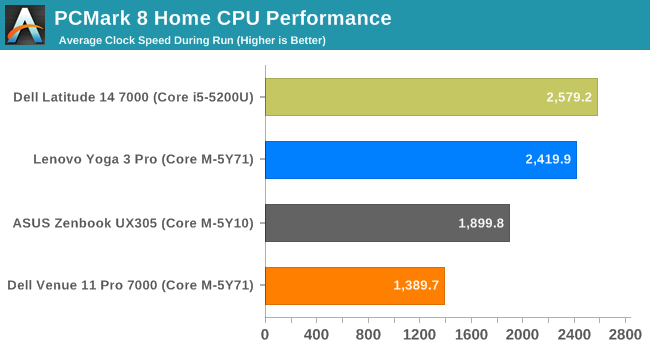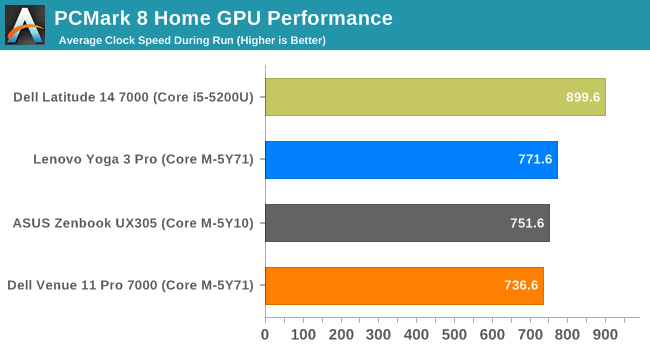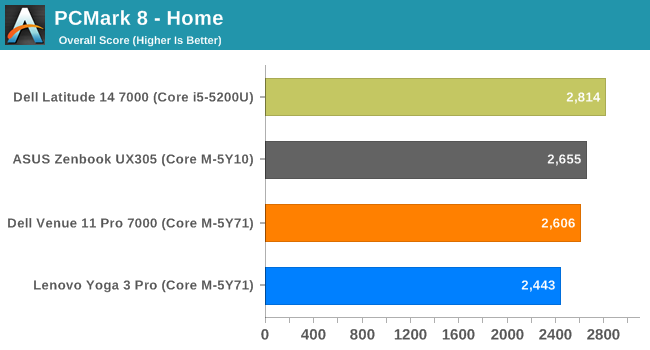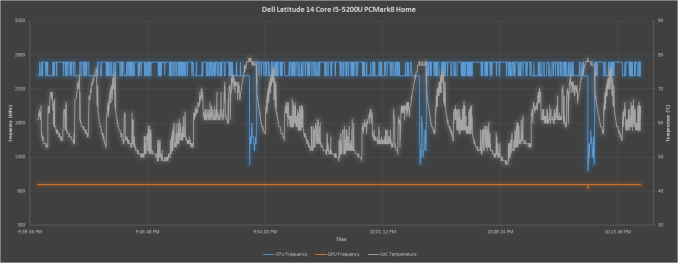Analyzing Intel Core M Performance: How 5Y10 can beat 5Y71 & the OEMs' Dilemma
by Brett Howse & Ian Cutress on April 8, 2015 8:00 AM ESTPCMark 8 Home Results
PCMark 8 Home is a much different workload than Cinebench. Cinebench thrives on sustained performance over the duration of the workload, with the CPU utilization staying around 100% for the duration. While an important metric, most people do not use their computers like that in their day to day lives, so Futuremark has crafted the PCMark suite to perform tasks which are more akin to what the average person will do in a day. Home includes workloads for web browsing, writing, gaming, photo editing, and video chat, and the nature of these loads mean that there is a lot more burst performance needed, so the race to sleep mentality of the Core M can be more effective in this scenario.
The burst nature of this benchmark is apparent just looking at the Core i5. No longer is the CPU frequency consistent across the board, and the temperatures ramp up and down as the work is performed and finished. Even more pronounced is the Dell tablet, which spikes up and down from its maximum temperature, but at the same time ramping clock speeds up quite high as well. The incredible cooling of the ASUS UX305 passive solution makes a big difference here, with the UX305 being able to maintain almost its maximum frequency for the duration of this benchmark. The Yoga 3 Pro really shines here though, with it maintaining quite high speeds for almost the entire duration of the benchmark.

Average CPU frequencies on the other hand show an unexpected disparity between the results we saw above and what the averages end up being. It's the cool Yoga 3 Pro that holds the highest average clockspeeds, followed by the UX305, and finally bringing up the rear is the Venure 11 Pro 7000.

The GPU averages for the three Core M devices are very similar overall, although none are at their maximum. Only the 15 watt Core i5 can maintain its maximum GPU frequency for the duration of this test. As we will see later, GPUs can draw a lot of power.

Moving on to temperature, with the burst nature of this benchmark, all of the devices have a reasonable time to cool off between workloads. The ASUS shows its amazing cooling capabilities again, with a significantly lower temperature than even both of the active cooled devices, but none of them are too close to their maximum allowed temperature over the duration.

Looking at the end result of this benchmark kind of throws everything we have seen in the above graphs on its head. The Yoga 3 Pro, despite sustaining a CPU frequency higher than all of the other Core M devices in this test, ends up scoring the worst, however the overall result by the Yoga 3 Pro is disadvantaged in this benchmark by the gaming test, due to the high resolution display on the Yoga 3 Pro. This is very similar to the results seen in the Dell XPS 13 review, where the QHD+ model only scored 2691 and the FHD model scored 3042 with the same processor. However the ASUS UX305 beats the other Core M devices, although it does so with a much lower resolution display than the Yoga 3 Pro which would certainly beat it otherwise.














110 Comments
View All Comments
zepi - Wednesday, April 8, 2015 - link
Surface pro 3 is ~50% thicker than iPad Air 2, weights ~50% more, has active cooling and still has poorer performance than Surface Pro 2.From my point of view Surface pro 3 proves that Haswell-U can't power ultra-thin x86 tablets.
lilmoe - Wednesday, April 8, 2015 - link
Didn't know the iPad was an ultra-thin x86 tablet that replace your laptop. Good to know, thanks.I get that the iPad has a huge fan base, I really do. But would you guys please stop comparing it to real PCs in tablet form already??
zepi - Thursday, April 9, 2015 - link
Central argument proposed was that SP3 somehow proves that Haswell-U can power ultra-thin X86 tablets. There were no mentions about Windows or OSX compatibility in original statement.Keyword is Tablet. x86, ultra-thin etc. are describe terms. You don't need to go far and see that the statement is clearly false. Ultra-thin in context of tablets means these days that thickness of the device should to be somewhere around 6-7mm. SP3 is 9mm. I picked iPad Air 2, because it is the most well known of competitors. We could just as well use Dell Venue 8. Ipad thickness is 6.1 and Dell is 6mm thick. Later is even x86 and runs windows
Weight was another thing. Naturally comparing weight to Venue 8 makes very little sense since SP3 has over twice the total screen area of Venue 8 so I compare it with iPad air 2, which has the biggest screen area of the most well known tablets in the market. Most certainly, there are some less well known 12" models, but they are not widely spread and have hardly any market penetration.
I cannot see how SP3 would prove that 15w TDP allows for compact tablet designs. SP3 is already thermally limited and mostly proves to me that in order to reach smaller and thinner designs, lower power SOC's are necessary. From my point of view SP3 is full computer which offers decent (though arguably best in class) tablet usability in addition of being dockable general purpose PC-computer.
digiguy - Wednesday, April 8, 2015 - link
come on, you change the comparison in the same sentence, SP3 is thinner and lighter than SP2, and has has higher res screen. As for ipad air, try to run Windows on it....Jaybus - Wednesday, April 8, 2015 - link
Or even if it ran OSX. The iPad is a giant iPhone. If it ran OSX, then we could compare it to SP3. For now, iPad can only be compared to Android tablets.xthetenth - Wednesday, April 8, 2015 - link
Being thicker than slower devices and slower than thicker devices only proves that it fits between them on a size/performance scale and does nothing to show that it's not a good device.ppi - Wednesday, April 8, 2015 - link
My desktop is also thicker than iPaid Air2, weighs more, has active cooling and certainly eats more power. So ... ?You have to realize, that this 4.5W chip actually has performance that is in league with 15W chip. For many ultrabook/2-in-1 use cases ideal chip. And read the Yoga3 review, where on CPU-bound benchmarks, Core-M runs circles around A8X.
frozentundra123456 - Wednesday, April 8, 2015 - link
I agree with some of the other posters. The problem is the price of these devices for the performance. I can see them for say business use, where the company is paying, use is light, and mobility is important (say for a sales rep who travels a lot), but otherwise, I cant see Joe Average Consumer paying north of 1000 for these when you can get similar perrformance for less in a 350.00 conventional laptop or less performance, but still decent in a 100 to 300 dollar atom device.xthetenth - Wednesday, April 8, 2015 - link
The ASUS is in the 700 dollar range and avoids a great many other compromises cheaper devices would make. It fits into the price/quality scale very nicely.zepi - Wednesday, April 8, 2015 - link
From gaming / usability perspective the average-results do not necessarily tell enough.Ie. does the usage experience of certain devices suffer because GPU / CPU throttles too much under certain loads?
Are the bottom 10% frametimes so horrendous on throttling devices that DOTA-gaming is practically out of question despite relatively small difference in average frame rates?